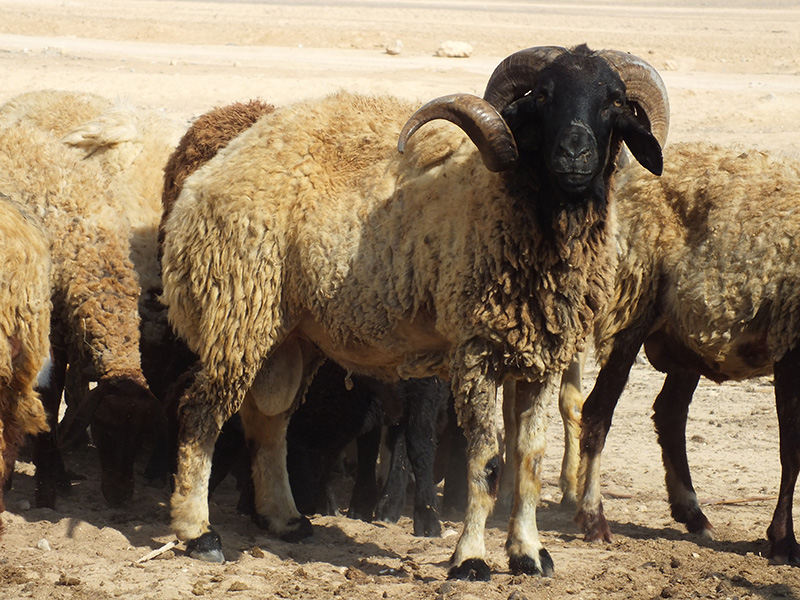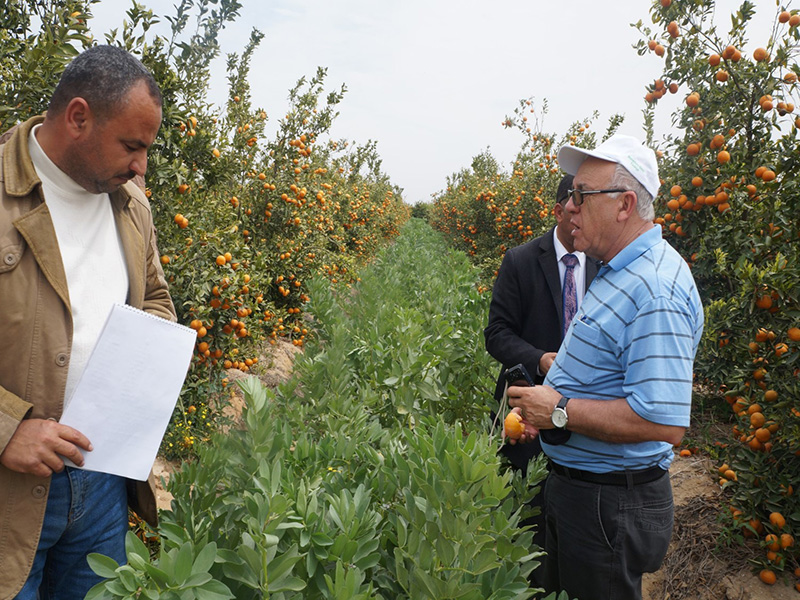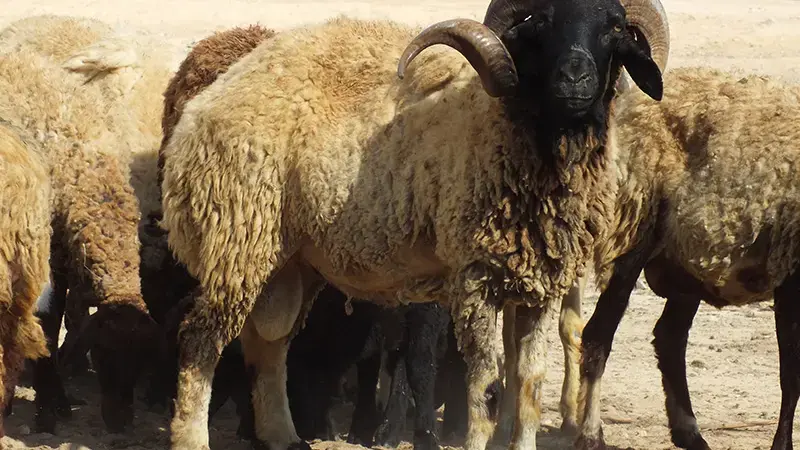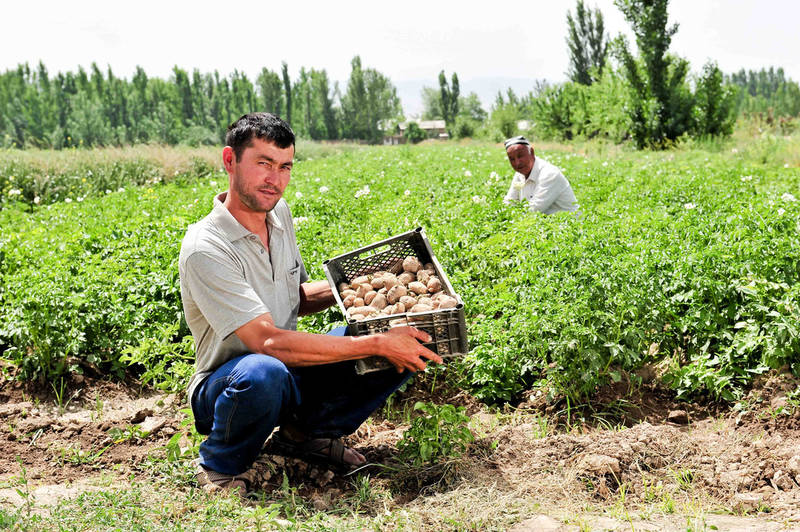In this issue
Are Sheep and Goats Ready for a Hot, Arid Future? Scientists discover genomic signatures in indigenous breeds for adaptation

Photo credit: Joram Mwacharo, ICARDA
The earth is getting increasingly parched and warmer, largely in the drylands of the world where climate change is predicted to have its worst impact. Adapting the farmers to changing climate is a defining challenge of our times so we can sustain food production for the world’s growing population.
There is yet another challenge we need to be worrying about. Will the sheep and goats be able to cope with the climate change?
Sheep and goats are a major source of income and livelihoods for the rural poor in dry and marginal areas. Drylands are home to some 2.1 billion people, with 16% living in chronic poverty who rely on sheep and goats to feed their families.
A team of small ruminant scientists from ICARDA, Egypt’s Animal Production Research Institute, and Iowa State University and Virginia State University in the USA, set out to determine the genetics of goats and sheep’s adaptation to hot and arid environments characteristic of dryland agroecosystems. The research investigated genomic signatures of natural selection for adaptation to hot and arid environments by using Barki goats and sheep indigenous to the Coastal Zone of the Western Desert (CZWD) in Egypt, and five exotic breeds of goats and three of sheep from the temperate regions, which would be poorly adapted to drylands.
“Temperatures run high in the CZWD, the quality of feed is poor and feed availability is scarce. Yet the Barki goats and sheep survive well. They must, therefore, have the genetic predisposition to survive these conditions”, says Joram Mwacharo, Small Ruminant Geneticist at ICARDA, explaining the basis of their selection of Barki animals from farmers’ flocks.
The team of scientists performed a broad brush genomic scan using the latest genomic tools and discovered Barki animals to have a different genetic makeup from that of the exotic breeds, most likely due to differences in their adaptive evolutionary history.
Several candidate genomic regions spanning 119 genes in both sheep and goats were identified that directly or indirectly play a role in adaptation to hot and arid environments. “These results clearly highlight the potential of indigenous breeds as the genetic resources of choice to mitigate against climate change,” says Barbara Rischkowsky, leading the Small Ruminant Team at ICARDA.
“Our next step is to further validate the results on a large sample set and perform a full genome sequence analysis on selected candidates to identify exact genomic regions and the associated cluster of genes for selective breeding,” says Mwacharo.
The drylands are expanding and expected to reach about half of global land coverage from 41% as of now, with most of it predicted to happen in the developing countries. Sheep and goats will remain key to enabling resilient livelihoods for the millions as we witness change in climate over the next few decades.
To learn more, read Multiple genomic signatures of selection in goats and sheep indigenous to a hot arid environment, Heredity, Nature, 11 November 2015.
Supported by: Agricultural Research Center, Egypt; CGIAR Research Program on Livestock and Fish; Iowa State University
Central Asia Gets a Forecast for Farm Incomes with Climate Change
Photo credit: Neil Palmer for IWMI
Impacts of changing climate on agricultural production are being experienced by farmers and herders around the world. However, the question being currently debated is how big will be the overall effect of climate change on the economics of agriculture in agrarian countries?
Evidence shows that there has been a general warming trend in Central Asian countries, around 1-2°C since the beginning of the 20th century. Despite being mostly arid and semi-arid region, agriculture constitutes a main sector in the Central Asian economies.
A recent study undertaken by socio-economists at ICARDA, funded by the Asian Development Bank, assessed the impacts of climate change at the farm level in Central Asia with focus on three main crops – cotton, potatoes, and wheat. These crops are crucial for the rural economies and food security in Kazakhstan, Kyrgyzstan, Tajikistan and Uzbekistan. The analysis factored in various greenhouse gas emission scenarios to develop a model for reliable conclusive results.
The study interestingly found impacts from climate change to vary in Central Asia, not just depending on the agro-ecological zones and socio-economic aspects, but also with progression of time. For example, in the near future (2010–2040), farmers in Uzbekistan will benefit from climate change due to more favorable weather conditions for crop growth; however, in the late future (2070–2100), their revenues are expected to decline due to increasing temperatures and worsening risk of water deficit.
For Kyrgyz farmers in semi-arid zones, impact of climate change on income will be neutral in the near future but is expected to benefit them in the late future. Farmers in sub-humid zones of Kyrgyzstan will probably have higher expected income in near and late future but also face higher production risks with weather extremes. In Tajikistan, impact of climate change will be crop specific. While wheat revenues may not change in the future, cotton growing may be less lucrative due to drop in yields if current levels of management are maintained. Potato farmers may receive higher revenues in the future as yields are expected to increase.
The study findings are filling an important knowledge gap for decision-makers in Central Asia, providing evidence to rationally convince policy-makers and elicit adaptive measures to secure farm incomes.
In a powerful insight, scenario simulations with the condition of market liberalization show great potential for policies to enable producers to mitigate negative consequences of climate change, especially in Tajikistan and Uzbekistan. Another finding of this study was that more open economic policies and less rigid trade policies can be effective adaptation strategies as trade barrier may limit farmers to shift to export crops or impose production of uncompetitive crops even if they are more likely to be affected by climate change.
The study was conducted in cooperation with CGIAR’s International Food Policy Research Institute (IFPRI) and Climate Change, Agriculture and Food Security (CCAFS).
To learn more, access full article: Impacts of climate change on farm income security in Central Asia: An integrated modeling approach, Agriculture, Ecosystems and Environment, April 2014, pp 245–255.
Supported by: The Asian Development Bank
Faba Bean Production Makes a Comeback in Egypt

Photo credit: Mohamed Soliman, Agricultural Research Center (Egypt)
The humble faba bean has cemented its place as the most important food legume in Egypt, providing much of the country with a good source of income and quality protein, popularly eaten as part of a traditional meal. However, faba bean productivity has been in dramatic decline in Egypt. It fell from almost 100 percent self-sufficiency in 2002 to 31 percent by 2012. The cause has been mainly crop infestation by foliar diseases and parasites such as Orobanche and chocolate spots, and shortage of water availability in the reclaimed lands – both factors aggravated by a changing climate.
A project aiming to adapt smallholder farmers in drylands to climate change is turning back the clock for faba bean production in Egypt. The project, funded by the European Union-International Fund for Agricultural Development partnership and implemented by ICARDA, has focused on enhancing wheat-legume cropping system in the region – a strategy that is demonstrating multiple benefits in the country: enriched soils, reduced land degradation, and increased smallholder profits and nutrition in rural diets.
The project introduced new improved varieties of faba bean along with a package of interventions that increased crop yield by 22.5 percent on average and stabilized it over three successive growing seasons. The released varieties such as 'Misr 3' and 'Giza 843' with resistance to Orobanche and foliar diseases, and adaption to low-water availability, have been the result of ICARDA’s ongoing research partnership with Egypt’s Agricultural Research Center.
The new varieties were popularized through demonstrations on farmers’ fields in combination with best practices, such as optimal seeding rate, integrated pest management, conservation agriculture, irrigation schedules, and intercropping faba bean with fruit trees.
Field days and farmer field schools held across five governorates gave optimistic results, and strong evidence for yield increase potential of faba bean in Egypt. Some demonstrations in Sharkia province recorded growth rates even higher at 38%.
“The demonstrations in the farmer fields allows us to compare their practices with the recommended package,” said Dr. Mohamed Soliman, Director of the Field Crops Research Institute in Egypt, in his presentation at the close-of-project meeting, held in Rabat, Morocco in October. “This will lead to increase in faba bean cropping area and productivity, and hence increase crop production in the country.”
The boost in faba bean production in Egypt is one of the many successes of the three-year project, which was implemented across eight countries in West Asia and North Africa. Scientists at ICARDA, in partnership with the NARS, helped improve productivity of lentil, chickpea, faba bean and wheat, as part of wheat-legume cropping system.
The success from improved faba bean technologies has inspired a ‘National Campaign on Faba Bean Rehabilitation’ for the coming season, initiated by the Egyptian Academy for Scientific Research and Technology.
Supported by: European Union-International Fund for Agricultural Development
In the SPOTLIGHT
ICARDA announces International Conference on Pulses for Health, Nutrition and Sustainable Agriculture in Drylands, in Marrakesh for 2016 International Year of Pulses (IYP 2016). For more information on this and ICARDA’s crops and projects, visit its new Pulses website at www.icarda.org/pulses
dryWIRE is published quarterly by Communications, Documentation and Information Services of ICARDA.
Articles contributed by: Rajita Majumdar (Editor) and Pratima Mathews

Dryland Systems is global agricultural research partnership to realize the potential of dryland communities. The program is a CGIAR initiative led by ICARDA.





